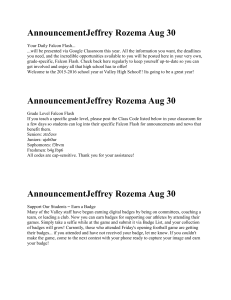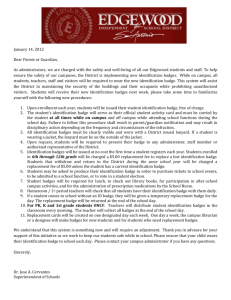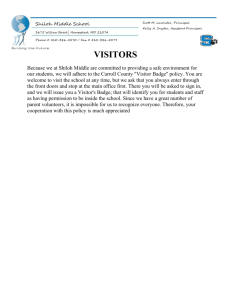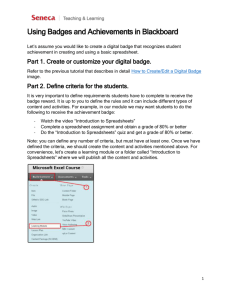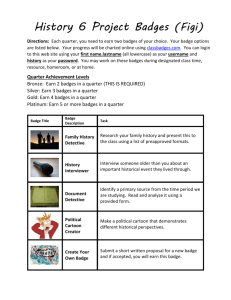Year 6 Badge Book 2015
advertisement
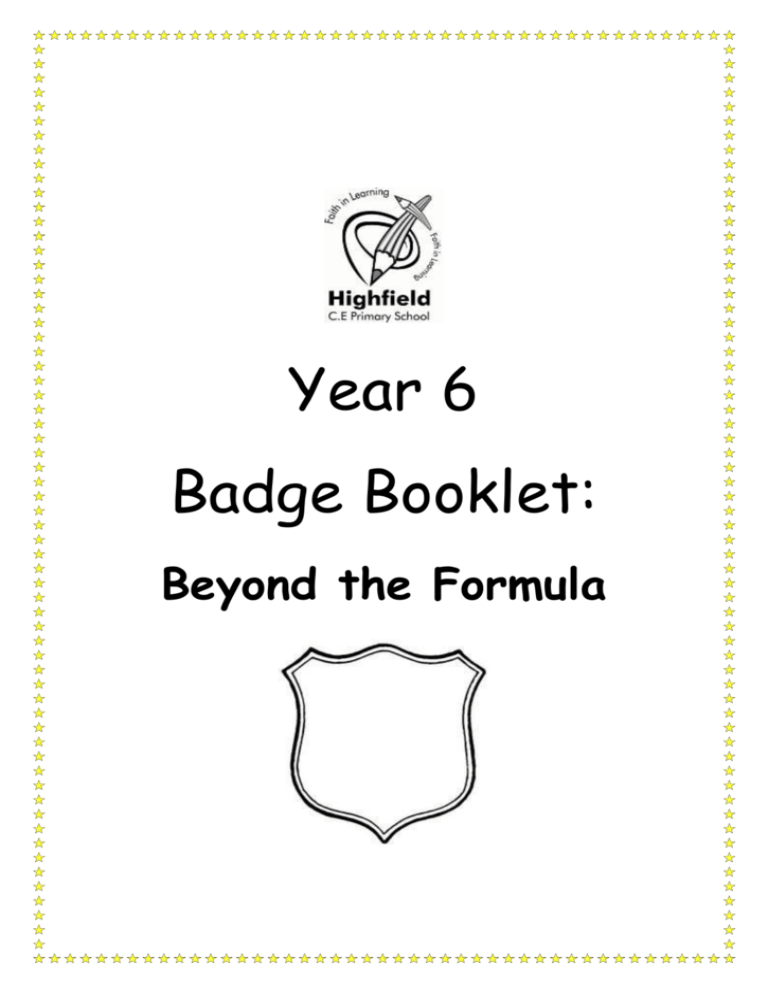
Year 6 Badge Booklet: Beyond the Formula This booklet contains information on the attainment badges that you will be able to work towards in Year 6. Some of the stickers can be earned at any point during the year (Times Tables, Handwriting, Reading), whilst others will be at special times set by your teacher. Some of these times will be on regular Prove It Days. On a Prove It Day, you will have the chance to show your teacher or another adult evidence that proves you have earned your badge. Unlike in Year 5, where you mostly had to just look for examples of relative clauses, ISPACE openers etc, Year 6 discussions will be mostly based around about a portfolio of your best pieces of writing. You will need to submit your chosen pieces to your adult a week before Prove It Day, and be ready to answer any questions they may have about them. Every time you earn a badge, you’ll be able to display it proudly on your sticker chart, and at the end of the year you will receive a special certificate with all of your earned badges on. Do your best to try and earn as many badges as you can! KS2 Any Time Badges Times Tables Handwriting Knowing your times tables off by heart Although more and more people are is an important part of your Maths using computers to word process their learning. They will help you with lots of writing now, it’s still important to be Maths topics, such as multiplication, able to write neatly with a pen too. division and area, as well as helping with Joined, evenly sized writing will not only your general memory skills. By Year 6, help your teacher read your work more you should definitely know your times easily, but will make it easier for you to tables up to 12 x 12. re-read and check it over too! Prove you’ve earned your badge by... Passing Mr King’s times tables test. You Showing your teacher that you have will need to answer ten questions up to used correctly joined, consistently sized 12 x 12 that Mr King gives you, with no handwriting in your Literacy book over more than 3 seconds thinking time for the past month. Although any notes or each one. planning don’t necessarily need to be in Speak to your teacher if you think you your best writing, longer texts certainly are ready to take this test. do! Your teacher will look for... - letters that are joined from and to the correct place. - similar sizes for all small letters (e.g. a, c and e); ascenders (e.g. b, d, h) and descenders (e.g. g, p and q) This example is a guide for how neat handwriting could look. By the time you reach Year 6, you may be developing your own style. Even so, you still need to make sure your letters are joined in a consistent way and correctly sized! Year 6 English Badges Spelling In the Autumn term of Year 6, your teacher will test you on the 100 words from the Year 5/6 list. Weekly spellings for the Spring term will then be partly taken from a list of any that you may have got wrong. If you score 95% or more in the Year 5/6 test, you’ll earn the Year 6 Spelling badge! If you get between 85% and 94%, you’ll have a chance to be retested on any incorrect words later that week, but you would need to get full marks to earn the badge! If you would like another chance to earn the badge later on in the year, you will be given the chance to be tested on the whole list again at the end of the Spring and Summer Terms. Full Year 5/6 Word List according achieve attached available average awkward cemetery committee community competition criticise curiosity desperate determined develop dictionary equipment excellent forty frequency government individual interfere identity immediately language leisure lightning marvellous mischievous opportunity parliament persuade physical prejudiced privilege pronunciation restaurant rhyme rhythm sacrifice signature sincerely sufficient symbol system variety vehicle environment queue interrupt muscle necessary neighbour occupy occur profession programme swap recognise recommend relevant secretary shoulder soldier stomach suggestion temperature thorough twelfth vegetable yacht category communicate embarrass accommodate accompany aggressive amateur ancient apparent appreciate bargain bruise conscience conscious controversy convenience correspond definite disastrous especially exaggerate existence explanation familiar foreign guarantee harass hindrance Reading Reading a variety of books is just as important in Year 6 as it ever was. You may well have a favourite author or genre by now, but it’s never too late to try something new! Prove you’ve earned your badge by... 1) Filling in details for at least one book from at least ten of the genres in the reading record in the back of your homework book. 2) Reading and reviewing at least three books, in the back of your blue guided reading book. These books must be suitable for a Year 6 reader. 1 non-fiction book. The review must have information about how the book is suitable for the intended audience, and include a description of, and your opinions on, the layout of the book. 1 novel. The review must include information / opinions on plot, characters, genre and themes. You need to include a quote from the text to justify your opinions in some parts, and you should make at least one comparison to either your own experience, something else you’ve read or to the wider world. 1 of the following options: - A book of short stories. The review must include information / opinions on plot, characters, genre and themes. - A poetry book. The review must have information about the style of poetry included, and some of the themes that the poems cover. - A play. The review must include information about the genre and themes in the play. Punctuation As you get better at writing and start to use longer, more complex sentences, correctly punctuating your work can make a big difference in how your reader understands what you are writing. By the time you leave Year 6, you should have an understanding of how to use the full range of punctuation. Prove you’ve earned your badge by showing on Prove- It Day, across three pieces of independent work: Consistently correct use of… - full stops - capital letters - exclamation marks - question marks - apostrophes - commas - correct speech punctuation Some correct use of all of the following: - brackets - dashes - hyphens - colons - semi colons - bullet points Fiction In Year 6, you will be given more opportunities to spend extended periods writing your own stories across a range of genres. You will be expected to plan and write your stories mostly independently, although your peers and teacher will still be able to offer suggestions and advice for improvement. It’s up to you how much you respond to these, but you’ll need to be able to explain why you have or have not taken the advice! Above all, your stories must be easy to understand and engaging for the reader. Prove you’ve earned your badge by discussing two completed stories on Prove It Day. You will need to submit these to your adult to read a week before the Prove It Day. The most important things to make sure are that they find them exciting and interesting, and that they are not confused by what’s going on, so you’ll need to make sure you’ve explained everything clearly. (Remember, your adult probably won’t have been there in the lessons when the stories were set!) You will need to be ready to answer the adult’s questions on the stories, which might be about... - The characters. (Describe at least two of the main characters. What are their roles in the story, and how do they develop over the course of the plot?) - The plot. (How does it begin? What problem does your character have near the start that starts the story? How does the plot develop over the story, and what is the climax and resolution to the main problem? How have you linked back to earlier points later on in the text?) - The genre and themes - The style (Where are some parts where you’ve tried to appeal to the reader by using some fantastic description, including techniques for imagery? Where have you used longer sentences for description, shorter ones for impact, and other tension building techniques?) - Any ways that you have edited and improved the story. Non-Fiction As with the story writing, you will also have more of an opportunity to plan and write your own non-fiction texts in Year 6. For these texts, you will need to adopt a certain style and choose your words carefully to get your information and, where appropriate, opinions across. Prove you’ve earned your badge by discussing three completed non-fiction texts on Prove It Day. You will need one from each of the following categories: 1) Persuasion / Discussion (e.g. persuasive letter, balanced/one-sided argument, advert) 2) Recount / Review (e.g. newspaper report, diary, biography, autobiography, book review) 3) Information (e.g. explanation text, non-chronological report, instructions) You will need to submit these to your adult to read a week before Prove It Day. You will need to be ready to answer the adult’s questions on the texts, which might be about... - Whole text structure (How is the purpose of the text clear in the introduction? How have you ordered the middle paragraphs, and how do they flow on from each other? How does your conclusion help to bring the whole text together?) - Paragraph structure (How does the first sentence make the topic of the paragraph clear? How have you developed your sentences as the paragraph carries on?) - Layout (How have you chosen a layout that makes the text interesting to look at, and still easy to follow and understand?) - The style (How does the style you have chosen suit the topic, text type and audience? For example, can you show examples of persuasive language in an argument, formal / technical phrases in an information text, and parts that are clearly aimed at the audience you are writing to?) - Any ways that you have edited and improved the text, and how you might improve it further, if you were given more time. For the fiction and non-fiction badges, your adult may suggest you make certain edits and improvements to a text before you have earned a badge. You should get this to them as soon as you can, by the next Prove It Day at the latest. Alternatively, you and your adult may agree that it would be better to submit a completely different text for the next Prove It Day. Year 6 Maths Badges On Prove It Day, you will have the chance to take a maths test with questions on all of the following objectives, taken from the areas of number, shape and measures. At any point in the year, you will also be able to earn a four operations badge. Number There are three Number badges that you can earn: Bronze, Silver and Gold. Bronze: 5 objectives proven Silver: 10 objectives proven Gold: 15 objectives proven Objectives Example Questions Example Answers Read and write numbers up to 10,000,000. Round any number to any power of ten. Identify the value of each digit in numbers given to three decimal places. Identify common factors of numbers under 100 and common multiples of numbers up to 12. Say whether any twodigit number is prime or not. - Write 6,076,008 in words. Six million, seventy-six thousand and eight. - Write five million, eight hundred and four thousand, three hundred and one in digits. - Round 484,747 to the nearest 1000. 5,804,301 - Round 392,729 to the nearest 10,000 - What is the value of the three in each of these numbers? - 734,942 - 84.753 - What are the common factors of 32 and 56? 390,000 - What are three common multiples of 8 and 12? - Which of the numbers below are prime? e.g. 24, 48, 72, 96, 120, 144… 5, 29, 53, 67 5 29 32 49 53 67 77 485,000 30,000 3 thousandths / 0.003 1, 2, 4, 8 Use common factors to simplify fractions and common multiples to give a pair of fractions the same denominator. Compare and order fractions, including fractions greater than 1. Add and subtract fractions with different denominators and mixed numbers. Multiply pairs of fractions and write the answer in its simplest form. Divide proper fractions by whole numbers. Know or be able to work out a good number of equivalent fractions, decimals and percentages Calculate decimal equivalents for simple fractions. Solve problems involving calculating percentages and use percentages for comparison 13 /4 /7 and 4/5 as a pair of fractions with a common denominator. 15 /35 and - Write these fractions in order of size, from smallest to largest. 3 - Simplify - Express 39 /12 3 /4 8/6 3/2 10/12 - What is 2/3 + 2 5/7? /4 10 28 /12 /35 8 3 /6 /2 3 3 8/21 (14/21 + 2 /30 (25/30 - 24 15 /21) - What is 5/6 - 4/5? 1 - What is 5/6 x 4/5 2 /3 (Simplify - What is 5/6 ÷ 3? 5 /18 - Write 85% as a number of twentieths. 17 - Which common fraction can be written as 33.33% when rounded to two decimal places? - Write 3/8 as a decimal 1 - What is 15% of 30? 4.5 (or 4½) - Which is the greater amount of money: 20% of £60 or 55% of £25? Explain your answer. 55% of £25, which is £13.75 compared to £12. /30) 20 /30) /20 /3 0.375 Create and describe number sequences that go up or down by equal steps. Use algebra to express missing number problems. - Describe this number sequence: 3.5, 4.3, 5.1, 5.9 Goes up in 0.8s - Create a sequence of 5 5.7 6.1 6.5 6.9 numbers that starts at 5.7 and goes up in a decimal number of steps. - Vicky had a pile of p – 9 = 13 notepaper on her desk. She used 9 pages and had 13 left over. Write an equation that will tell you, when solved, how many pages (p) there were to begin with. 7.3 Objectives Measures Example Questions Convert between miles and kilometres. - What are 3 miles in kilometres, approximately? 4.8 kilometres (if we say that 1 mile = 1.6 km) - What are 4 kilometres in miles, approximately? - What is the area of this triangle? 2.4 miles (if we say that 1km = 0.6 miles) 10cm2 (1/2 x 5cm x 4cm) Calculate the area of parallelograms and triangles. - If each square is 1cm2, what is the area of the parallelogram? Example Answers 6cm2 (base x height = 3x2) Use formulae to find the area and volume of shapes. - Show how a formula can be used to calculate the volume of this cuboid: Compare volumes of cubes and cuboids. A has the larger volume, by 2cm2 - Which cuboid has the larger volume, and by how much? Objectives area = length x width x height = 1mm x 2mm x 2mm = 4mm2 A = (3 x 2 x 2) = 12cm2 B = (1 x 5 x 2) = 10cm2 Shape Example Questions Example Answers Draw 2D shapes when the side lengths and angles are given to me. Draw nets for 3D shapes. - On squared paper, draw an E.g. isosceles trapezium with two 45˚ angles. Compare and describe 2D shapes using mathematical language. - Name three properties of a rhombus. E.g. Two pairs of parallel sides; all sides are the same length; two lines of symmetry. - Name a property shared by an isosceles trapezium and an isosceles triangle E.g. They both have one line of symmetry. - Draw a net for a triangular prism. Name the radius, diameter and circumference of a circle and know that the diameter is twice the radius. - Label the radius, diameter and circumference of this circle: - If a circle’s radius is 3.5cm, what is its diameter? Find missing angles in - What is the size of the triangles, on a angle x in each example? straight line or at a point. 7cm 65˚ 95˚ 206˚ Describe positions on - What are the cothe full co-ordinate ordinates of the circle? grid. (-2.5, 0) Translate and reflect shapes on a co-ordinate grid. P: (-3, -5) Q: (3, -5) R: (3, 1) S: (-3, 1) - Describe the co-ordinates of square PQRS if it is translated three units left. - Describe the co-ordinates of triangle ABC if it is reflected in the y axis. A: (-2, 1) B: (-1, -3) C: (-4, -3) 4 Operations There are three 4 Operations badges that you can earn: Bronze, Silver and Gold. Bronze: 2 objectives proven Silver: 3 objectives proven Gold: 4 objectives proven To earn these badges, get the questions for that rung correct 4 weeks in a row on the weekly practice. Objectives Example Questions Example Answers Add together numbers with more than four digits using column addition. What is 32426 + 54718? Find the difference between two fourdigit numbers using column subtraction. What is 32968 – 13242? Multiply one-digit numbers with up to two decimal places by whole numbers. What is 865 x 2.24? Divide 4-digit by 2digit numbers using long division, including where answers may have up to 2 decimal places. What is 1648 ÷ 23?
